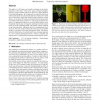16 search results - page 3 / 4 » Stereo Matching with Reflections and Translucency |
CVPR
2006
IEEE
14 years 7 months ago
2006
IEEE
Helmholtz stereopsis is a surface reconstruction method that exploits reciprocity for the recovery of 3D shape without an assumed BRDF model, and it has been shown to yield high q...
ICCV
2003
IEEE
14 years 7 months ago
2003
IEEE
To what extent can three-dimensional shape and radiance be inferred from a collection of images? Can the two be estimated separately while retaining optimality? How should the opt...
MVA
1994
13 years 7 months ago
1994
The idea of photometric stereo is to serially vary the direction of incident illumination on the state of the holded view point, but it can locally reconstruct only the front surf...
Book
A DRAFT computer vision book by Prof. Richard Szeliski. The book reflects the author's wide experience in practical computer vision algorithms that he has developed while work...
TOG
2008
13 years 5 months ago
2008
The quality of a 3D range scan should not depend on the surface properties of the object. Most active range scanning techniques, however, assume a diffuse reflector to allow for a...

